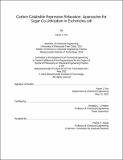| dc.description.abstract | Bioprocessing provides a sustainable, renewable, and green alternative to petroleum-based methods for the production of chemicals. A primary reason for the benefit of bioprocessing is its ability to utilize waste materials containing sugars as a feedstock, such as those from agriculture. This advantage is complicated with Escherichia coli due to carbon catabolite repression (CCR), an intrinsic sugar preference system. The relaxation of the effects of CCR has the possibility to increase bioprocessing’s economic viability and sustainability through better feedstock utilization. In this work we examine reported strategies for the relaxation of CCR and describe novel methods for the utilization of sugar mixtures for the production of an industrially relevant chemical.
A microbial production platform was developed to synthesize enantio-pure D-glyceric acid, a chemical with potential use in the materials industry, from D-galacturonate. The expression of udh from Pseudomonas syringae and gli from Agrobacterium fabrum, along with the inactivation of garK, encoding for glycerate kinase, enables D-glyceric acid accumulation by utilizing the endogenous expression of garD, garL, and garR. Optimization of carbon flux through the elimination of competing metabolic pathways led to the development of a ΔgarKΔhyiΔglxKΔuxaC mutant strain that produced 4.8 g/l of D-glyceric acid from D-galacturonate, with an 83% molar yield. Additionally, a substrate-based induction platform was developed that enabled the expression of udh and gli upon the addition of D-galacturonate by utilizing the transcription factor ExuR from Bacillus subtilis, eliminating the need for chemical induction.
Two strategies for CCR relaxation were investigated; one employing a global alleviation strategy and the other a sugar-specific strategy. A mutation in EIIAglc, an essential part of the phosphoenolpyruvate transferase system (PTS), was investigated as a global CCR relaxation strategy due to its ability to lock the protein in its phosphorylated state, mimicking a lack of glucose. While this engineered strain did co-utilize sugar mixtures, this phenotype was not stable. To enable sugar-specific CCR relaxation, the galacturonate-specific permease ExuT was engineered to lessen the effects of inducer exclusion. A galacturonate-specific biosensor was utilized to perform high-throughput screening of an exuT mutant library to search for mutants that enabled higher levels of intracellular galacturonate. Utilizing the synthetic pathway to produce Dglyceric acid from galacturonate, a S391R mutant of ExuT increased titer by 20% when a co-feed of galacturonate and glucose was used.
An analysis of the opportunity for synthetic biology to disrupt the specialty chemicals industry was performed. Synthetic biology firms should leverage their capabilities to utilize sustainable feedstock and synthesize novel products to differentiate and limit commoditization. Competitive landscape analysis displayed the relative success of the differing strategies of current players. | |
